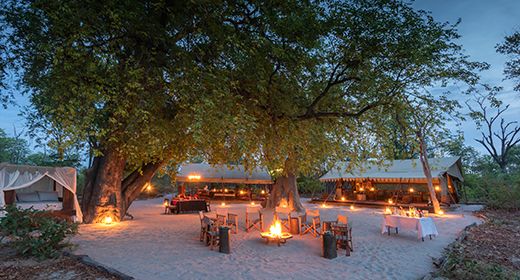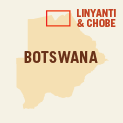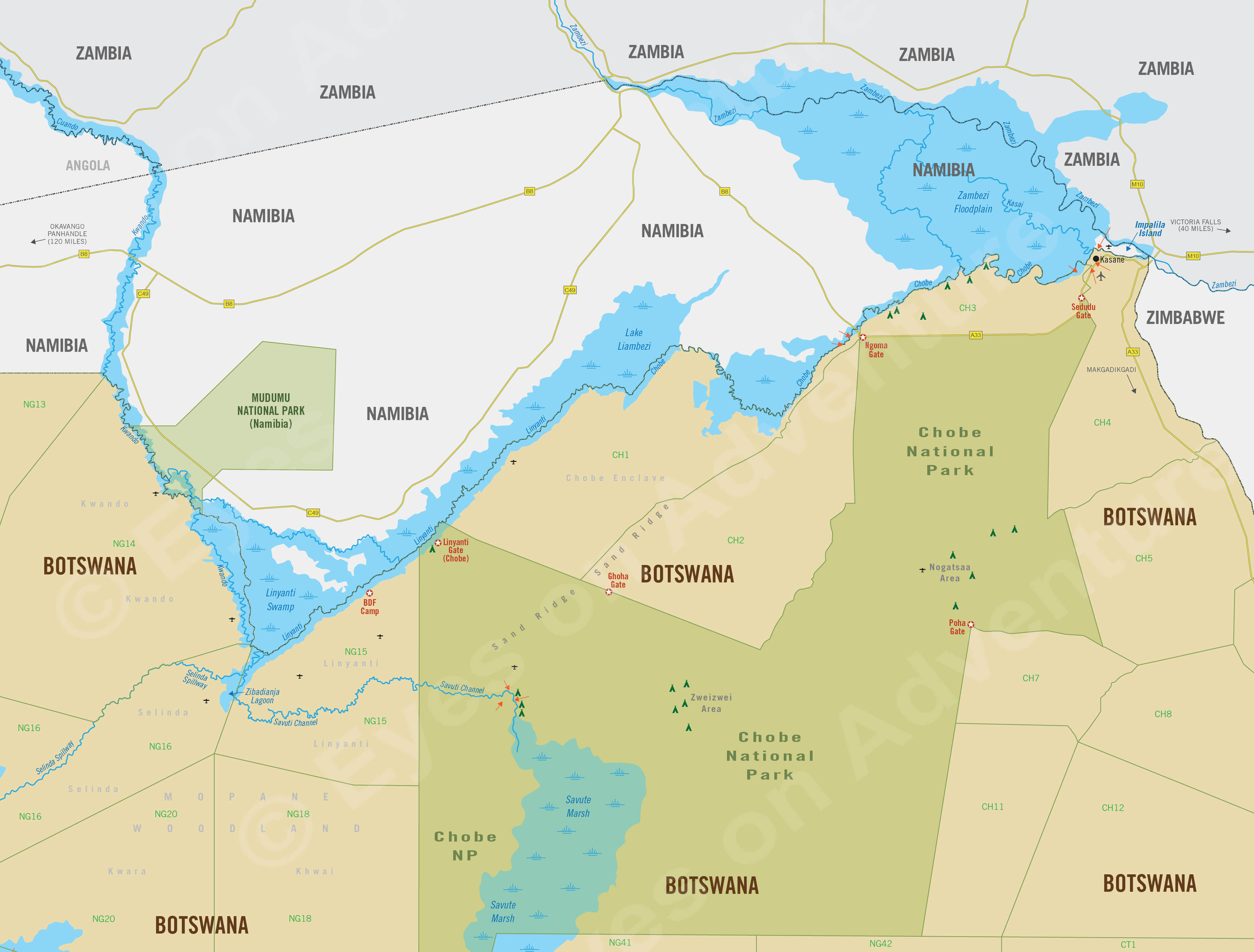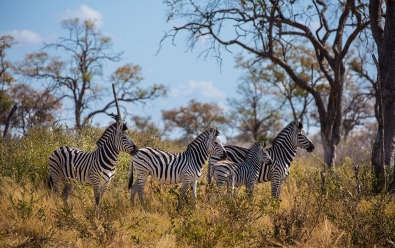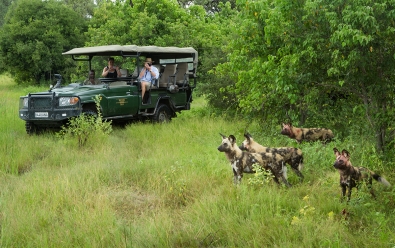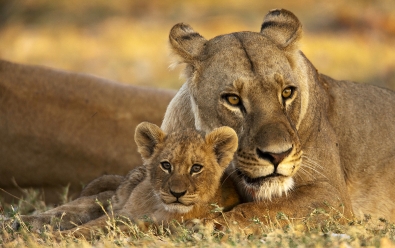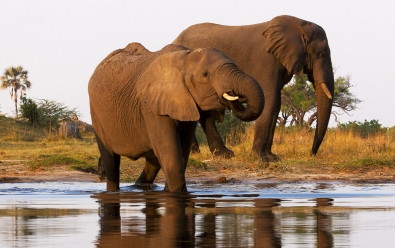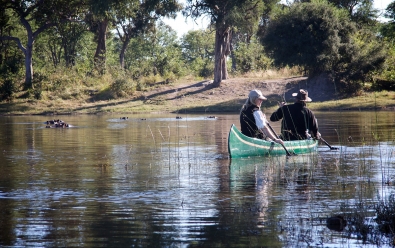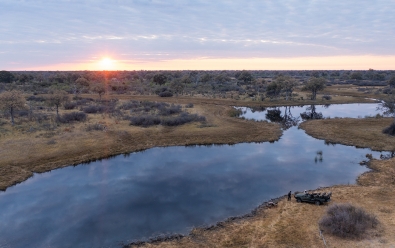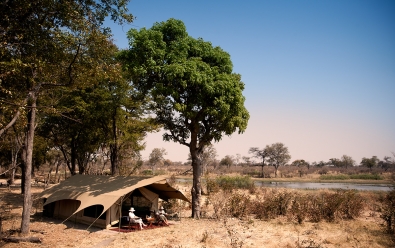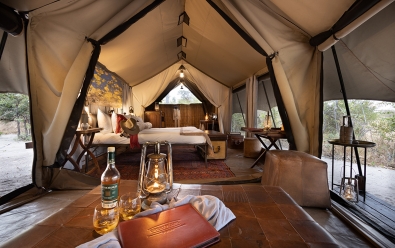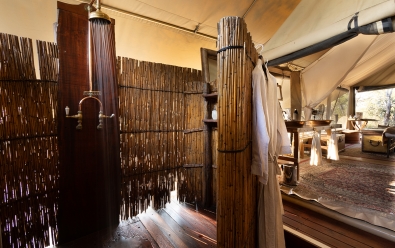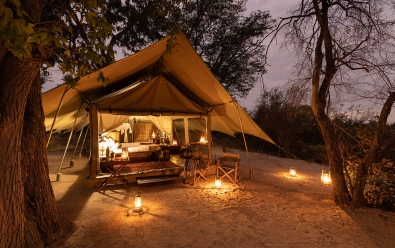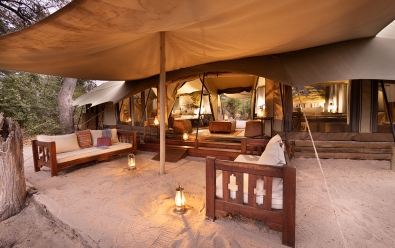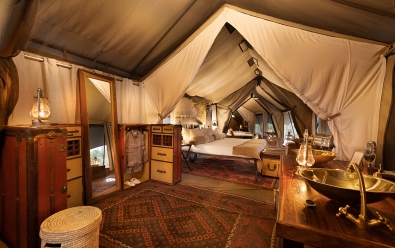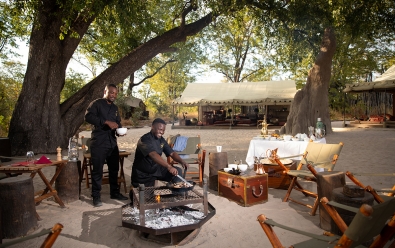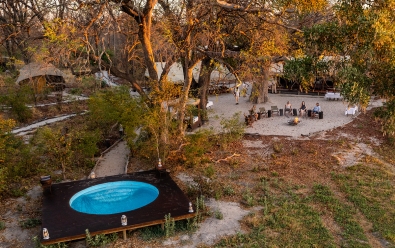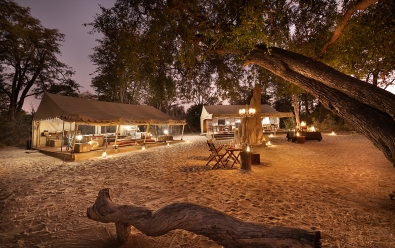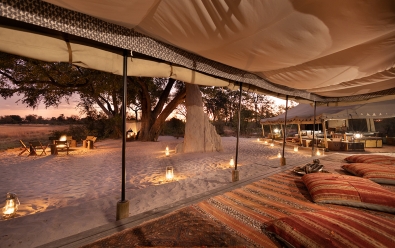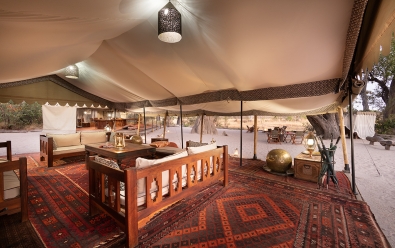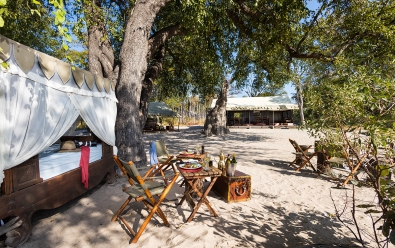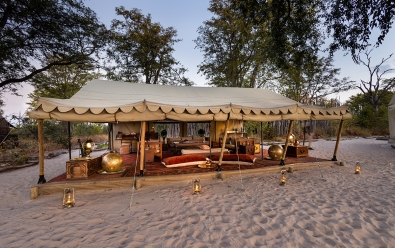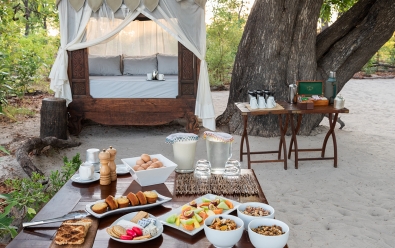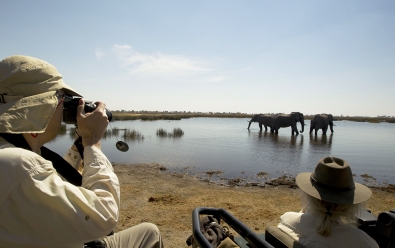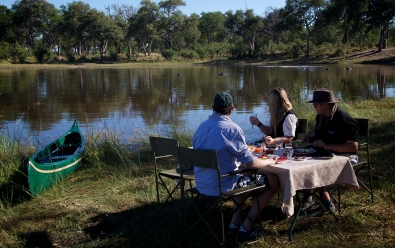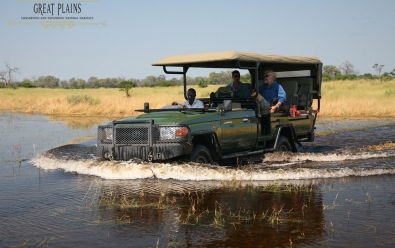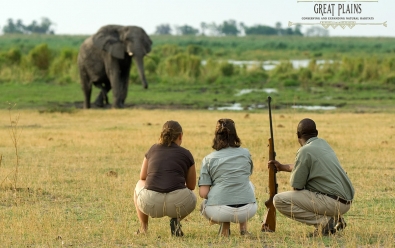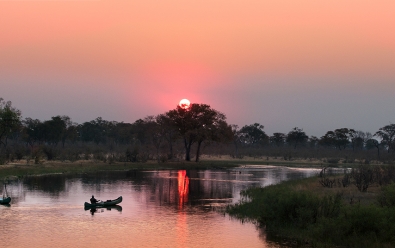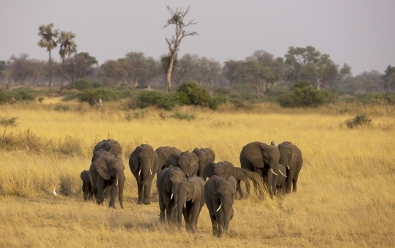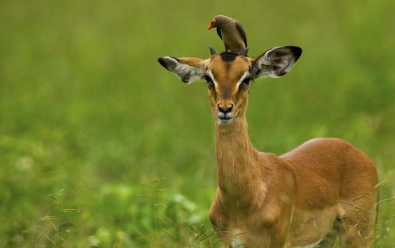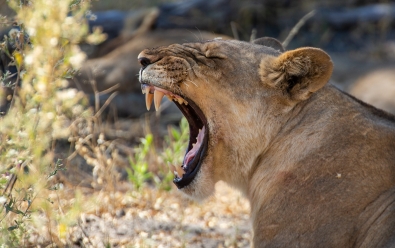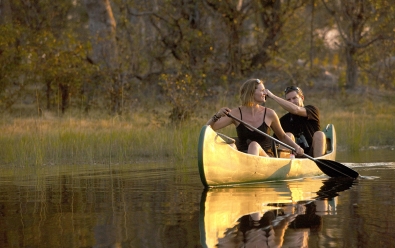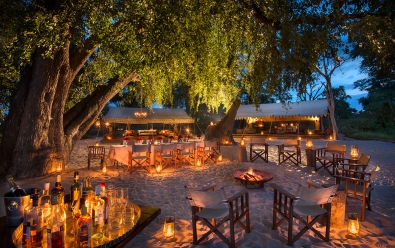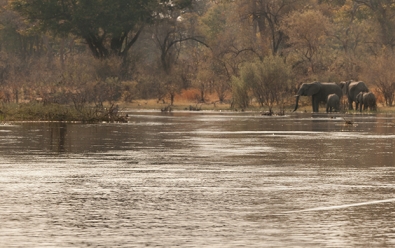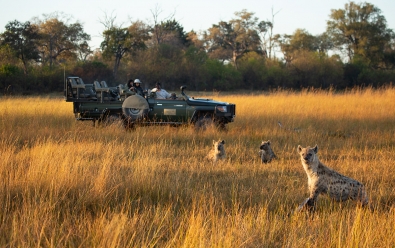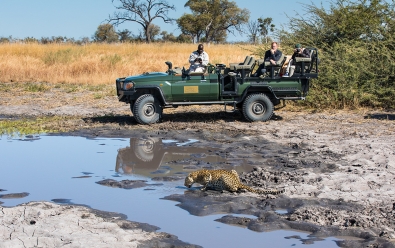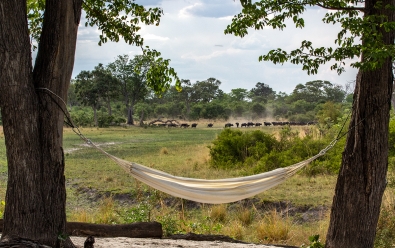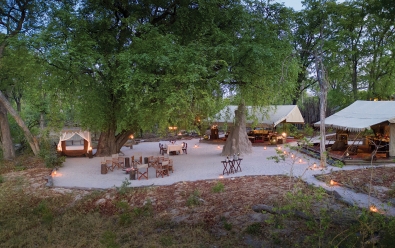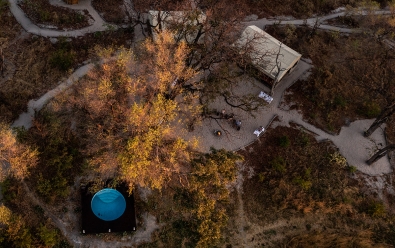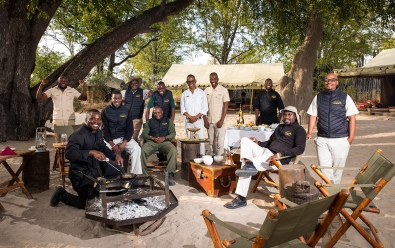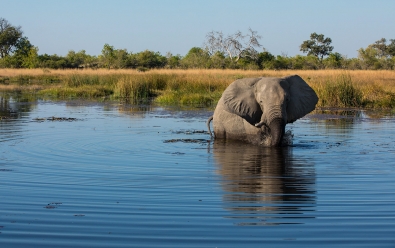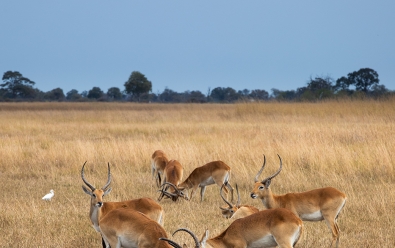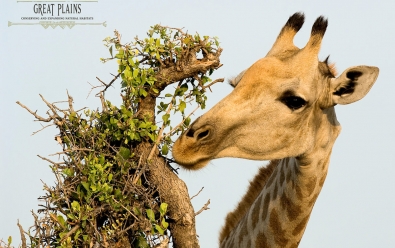Selinda Explorers Camp
Highlights
- Small and romantic camp with just 4 guest tents.
- Superb wildlife destination in a wilderness setting.
- Modeled after a mobile safari camp of early explorers.
- Game drives, canoeing, walking, fishing.
Location
- NG16 Private Concession
- Selinda Spillway
- Northern Botswana
Selinda Explorers is small and romantic, designed to emulate the luxurious, mobile safari camps of yesteryear, but with modern conveniences and hospitality.
Selinda Explorers is one of just a few safari camps in the 500-square-mile (1 300-sq-km) Selinda Reserve, so guests staying at the camp will enjoy a truly exclusive experience in this vast and untouched region north of the Okavango Delta. The camp overlooks the seasonally flooded Selinda Spillway, which flows out of the Linyanti swamp and is a crucial source of water for the area's wildlife.
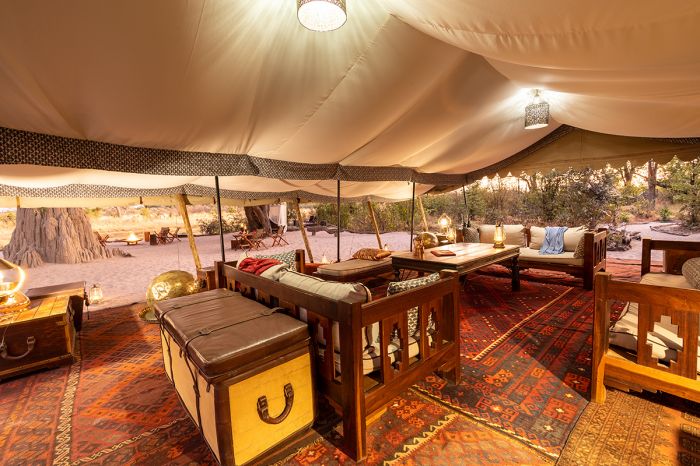
The Bedouin-style, open-air lounge at Selinda Explorers Camp.
Selinda Explorers Camp is owned and operated by Great Plains Conservation, an organization whose mission is to blend sustainable tourism with the conservation of wildlife environments. Great Plains is headed by the husband-and-wife team of Beverly and Dereck Joubert, who are well known to wildlife enthusiasts for their outstanding films, most of which have been created in conjunction with National Geographic.
Great Plains use the term “Conservation Tourism” to describe what they do. They define it as the use of quality-led tourism experiences that are environmentally sound, with the benefits going specifically into making the conservation of an area viable and sustainable.
The Great Plains model takes stressed and threatened environments, surrounds them with compassionate protection and intelligent, sustainable management, and funds them with sensitive, low-volume, low-impact tourism.
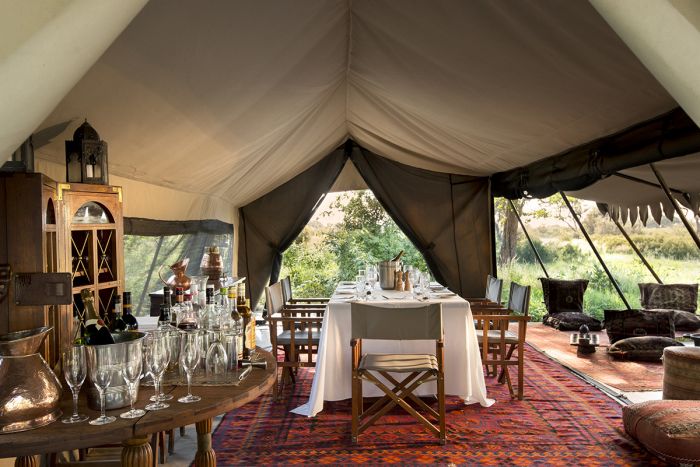
The dining tent at Selinda Explorers Camp.
Wildlife viewing in the Selinda Reserve is superb, with large numbers of both predators and herbivores, including lion, leopard, African wild dog, spotted hyena, elephant, buffalo, giraffe, zebra, red lechwe, tsessebe, waterbuck, impala, greater kudu, and more. The lagoon is home to large numbers of both hippo and crocodile. Bird life is also prolific and diverse.
The camp focuses primarily on the traditional safari activities of walking and canoeing (when there is water in the Selinda Spillway, which is not a given seasonally nor every year). Game drives are also offered and conducted in custom-designed, open 4x4 vehicles. For those wanting to keep active, a guided bush walk is another great was to see the little things that are often missed on a safari drive. Seasonal fishing is also offered.
Selinda Explorers Camp offers only four classic, Meru-style safari tents, one of which is a two-bedroom tent suitable for two couples traveling together or a family with children. The tents evoke the romantic and adventurous time of the early European explorers, with campaign-style furniture, Persian rugs, and brass and copper fixtures. The tents include plumbed, en-suite facilities with a hot-and-cold water shower, wash basins, and flush toilet.
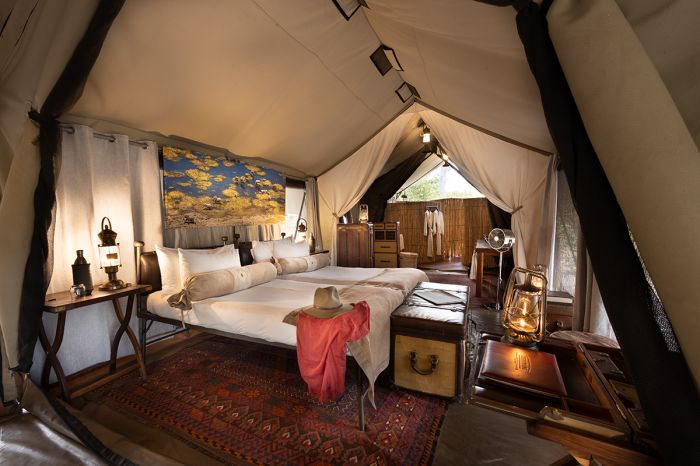
Guest tent interior at Selinda Explorers Camp.
The main camp area is constructed beneath shady trees and is designed to emulate the mobile safari camps of Africa's early explorers. Two Bedouin-style, open-air tents, one which is a lounge with relaxing seating and the other a dining space, form the main guest area. The authentic classic-safari look and feel of the camp creates a nostalgic atmosphere of elegance, mixed with adventure and relaxation. A plunge pool offers a cool respite for the midday hours between activities.
Great Plains are one of Africa's leading safari operators and they strive to minimize energy consumption at all their camps. Selinda Explorers Camp was constructed using only recycled hardwoods and canvas. Most of the camp’s electricity comes from solar energy.
Strict eco-friendly environmental standards are maintained so that no harmful chemicals or waste is allowed to enter the pristine ecosystem of the Selinda Reserve.
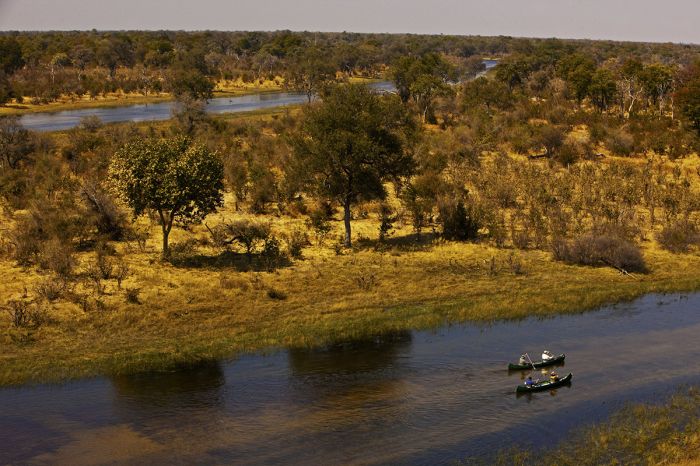
Canoeing on the Selinda Spillway at Selinda Explorers Camp.
the Northern Reserves (Linyanti, Kwando, Selinda)
Located directly to the north of the Okavango Delta are three superb wildlife reserves: the Linyanti, Selinda, and Kwando. All three reserves offer superb game viewing in huge wilderness areas with very low tourist numbers.
Each of the reserves has a number of safari camps and they all pair superbly with a visit to one more more camps in the Okavango. Daily charter flights are available from any of the camps in the Okavango Delta or elsewhere in northern Botswana.
Similar to the Okavango Delta, the northern reserves receive water from rivers fed by rains in northern Angola, the amount varying year to year. The Kwando River forms the border between Botswana and Namibia, and much like the Okavango River further west, it also empties into a trough of Kalahari sand, creating the Linyanti Swamp, a much smaller version of the Okavango Delta. The Linyanti Swamp empties eastward into the Linyanti River, which becomes the Chobe River further to the east.
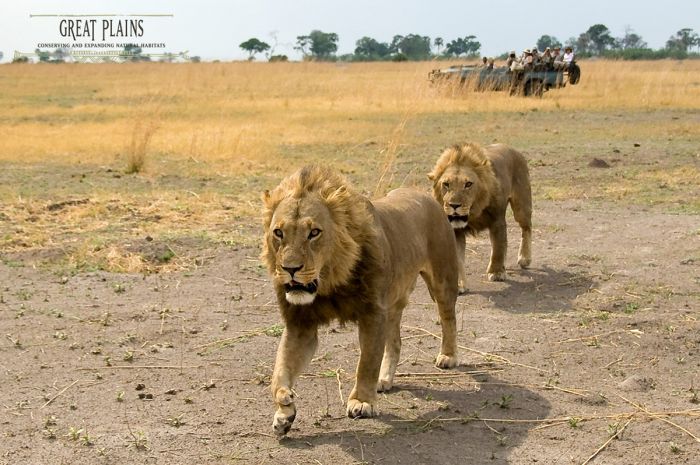
The Selinda is excellent for seeing predators like these lions.
In some years, and usually in multi-year cycles, the rain water flowing down the Kwando River is sufficient enough to cause the Linyanti Swamp to overflow to the south, where it may flow east into the Savuti Channel or southwest into the Selinda Spillway. The Savuti Channel empties into the Savute Marsh in Chobe National Park. The Selinda Spillway flows back into the northern part of the Okavango Delta.
Both of these waterways have historically gone through long periods of total dryness, becoming rich grasslands, and then suddenly flowing with water again, bringing rich sediments and new water along their courses. Like the Okavango, water flows are dynamic over time, with rains in the Angolan highlands and tectonic movements far beneath the surface of northern Botswana affecting the quantity and direction of the water in these river systems.
Away from the major rivers in the northern portion of these reserves, the southern portion of the northern reserves is dominated by dry woodland, consisting of Kalahari apple-leaf bush, mopane trees and Acacia trees on deep Kalahari sand.
Elephants wander through as they travel between the Okavango and the northern rivers, and there are impala, greater kudu, roan antelope, sable antelope, but this area is mostly not used for safaris, with the safari camps located along the waterways to the north.
Wildlife viewing along the waterways in the northern reserves is outstanding, particularly between July and late October, when the bush is dry and the animals stay close to the permanent water. Elephants gather in large numbers at this time and head to the waterways to drink twice daily, sometimes swimming and playing in the deeper water. Herds of buffalo, zebra, and impala are also present in good numbers. Other herbivores include include greater kudu, giraffe, red lechwe, tsessebe, waterbuck, blue wildebeest, and warthog.
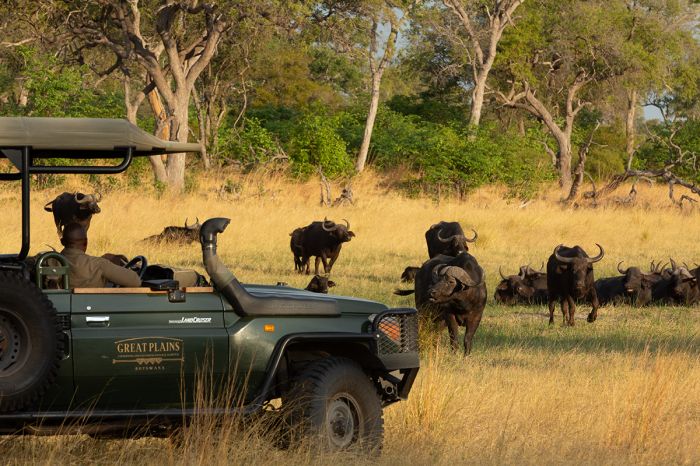
Game drive from Selinda Explorers Camp.
Common predators include lion, leopard, spotted hyena, black-backed jackal, and African wild dog. The northern reserves are one of the best places in Africa to see the wild dogs, which have their young around June each year, the pups are truly something to see if you get lucky. Cheetah are here in modest numbers and can be seen in the open grassland areas. Hippo and crocodile are abundant in the Kwando, Linyanti, and Chobe Rivers, as well as in the Linyanti Swamp area. Chacma baboon and vervet monkey are found in the riparian forests.
Birding in the northern reserves is outstanding, with a diverse mix of grassland, woodland, raptors, and water species found. A typical safari day can easily produce 100 species.
ROOMS INCLUDES & EXCLUDES CHILDREN FACILITIES ACTIVITIES
Accommodation
4 guest accommodations in total comprising:
- 3 semi-permanent, Meru-style, canvas safari tents. Double or twin-bedded setup are both available.
- 1 two-bedroom, semi-permanent, Meru-style, canvas safari tent designed for a family or two couples traveling together. Double or twin-bedded setup are available for each bedroom. Each bedroom has its own separate fully-plumbed bathroom, which is covered, but open-air, and located to the rear of each bedroom and includes a shower and flush toilet. Each bedroom also has its own double-wash basin located inside the tent.
Each safari tent includes campaign-style furniture, Persian rugs, and brass and copper fixtures. The fully-plumbed bathrooms are covered, but open-air, adjoining the tents at the rear, and include a shower and flush toilet. A double-wash basin is located inside the tent.
The guest tents are connected to the main camp area by sandy footpaths on the ground.
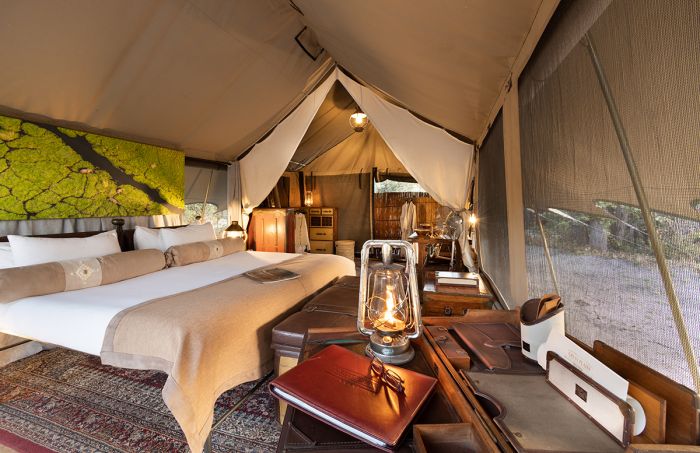
Guest tent interior at Selinda Explorers Camp.
The style of the camp and its guest tents evokes adventure and nostalgia, brining one back to stories about the early days of colonial exploration in East Africa.
The tents include specially-crafted furnishings that replicate those used by the early explorers from a bygone era, creating a romantic experience. The interior décor is sourced from Zanzibar and the Far East, with colorful rugs and recycled hardwoods.
The tents are at ground level on slightly-raised, wooden platforms. In front of each tent is a covered veranda with seating. The rear of the tent opens onto a partially-enclosed and covered outdoor shower and flush toilet.
Other items and features in all of the guest units include:
- Writing desk and chair.
- No mosquito netting over the beds, but the tents are completely enclosed with canvas and mesh.
- Electronic safe.
- Standing fan.
- Yoga mats.
- Wi-Fi in the guest tents and main camp area.
- The tents have individual solar panels for 24-hour electricity.
- A battery charging station is in the main camp area with international plug sockets including UK, Europe and USA.
- Personal amenities, including soap, shampoo, conditioner, and lotion.
Selinda Explorers Camp can accommodate a maximum of 10 guests in total: 2 guests in each of the three standard tents and up to 4 persons in the two-bedroom tent.
Includes & Excludes
Includes:
- All meals and alcoholic and non-alcoholic beverages, including premium beverages.
- Safari experiences (twice-daily or full-day game drives, bush walks, canoeing subject to water levels, seasonal fishing, and birding) accompanied by an experienced guide.
- Laundry services are provided on a daily basis (weather permitting, items will be returned on the same day). Laundry is dried by the sun and on most days any laundry placed out in the morning will be returned by the evening.
- Return, scheduled, seat-in-plane air transfers from Maun and/or Kasane Airports, as well as inter-camp air transfers from properties in the greater Okavango Delta and Linyanti/Savuti regions to this camp (subject to a minimum 2-night stay).
- Selinda airstrip transfers.
- Wi-Fi access.
- Tourism Levy & VAT.
Excludes:
- Scenic helicopter flights ranging in cost based on duration. Best to book in advance.
- Any applicable wildlife fee, park fee, reserve fee, concession fee, other land-use fee.
Single Supplement
A single supplement may apply for any room booked by a single traveler; please ask us for pricing.
Children
Children aged 6 years and older are accommodated at Selinda Explorers Camp:
- The family tent can accommodate a family of 2 adults and 1 or 2 children.
- Child rates are applicable for up to two children aged 15 and younger sharing with two adults in the family tent.
- Should the family tent be unavailable, child rates are applicable for up to one child aged 15 and younger, sharing with one adult in a tent.
- Children 15 and younger must share a room with at least one adult.
- Children aged 16 years and older will pay applicable adult rates and be accommodated in a separate tent.
- Families will be combined with other guests on all activities.
- Activities will cater to family ability and safety. Some activities have a specific age-related restriction.
- Children can participate in walking activities from 8 years of age (Young Explorers program excepted).
- Children can participate in canoeing activities from 12 years of age.
- Walking is possible from 6 years of age if guests are in the Selinda Suite or have confirmed the additional services of a private vehicle.
- Young children must be supervised by their parents, as the camp is not fenced and is located in an area with high predator densities and there is water often surrounding camp.
- The Great Plains Young Explorers program is thoughtfully designed to give children a range of experiences and topics from birding to cooking, to art, to wildlife tracking.
Facilities
Selinda Explorers Camp is situated on the bank of the seasonal 'Selinda Spillway', which is a waterway that flows out of the Linyanti Swamp. The camp is about an hour's drive west of its sister camp, Selinda Camp. Regardless of the season, the Spillway attracts a variety of wildlife, which is often seen right from the camp.
The main camp area is constructed beneath a shady riparian forest of mopane and jackalberry trees and is designed to mimic the mobile safari camps of Africa's early explorers. The main camp consists of two Bedouin-style, open-air tents; one which is a lounge with relaxing seating and the other a dining space.
The authentic classic-safari look and feel of the camp creates a nostalgic atmosphere of elegance, mixed with adventure and relaxation.
Main guest area facilities include:
- Two open-air tented spaces, one for a lounge and the other used for dining.
- Campfire area with seating.
- Refreshing plunge pool with a small deck.
- A shaded daybed / sala for relaxing while watching for wildlife and birds.
- A bar with a coffee-and-tea station.
- Dining is typically communal, but private dining is available on request.
- All dietary requirements are catered for, from regular to vegan to children; prior notice required.
- Complimentary Wi-Fi access.
- Mobile phone signal unavailable.
- Mineral water is provided in the main camp areas and in the guest tents.
- A battery charging station is in the main camp area with international plug sockets including UK, Europe and USA.
- The camp is run by a combination of individual solar panels for each tent with generator back-up.
Activities
Selinda Explorers Camp focuses primarily on the traditional safari activities of walking and canoeing when there is water in the Selinda Spillway (which is not a given seasonally nor every year). Game drives are also offered.
Activities included in the rate:
- Twice daily (or full-day with picnic lunch) game drives. Drives after dark are also offered. The vehicles are custom-built Land Cruisers that are designed specifically for the conditions around the camp and photography (fold-down screens, raised roofs, photographic bars, multi-plug inverters) with seven individual bucket seats.
- During winter months, hot water bottles (on early morning game drives only), blankets, and lined ponchos are provided.
- Guided walks led by licensed guides with firearm training.
- Birding.
- Canoeing on the Selinda Spillway, water-levels dependent.
- Seasonal (between March and December) rod-and-reel fishing on the Selinda Spillway on a catch-and-release basis.
Optional activities at additional cost:
- Private activities are on offer (subject to vehicle availability which needs to be booked in advance).
- Scenic helicopter flights ranging in duration from 30, 45 to 60 minutes. The activity is best between 11:00 and 15:00, when animal densities are high. Must be booked in advance.
Example of a typical day:
- Early morning wake-up call. Morning wake-up and activity times vary according to the seasons, activities on offer, and wildlife sightings.
- Light breakfast before departing on the morning activity.
- Return to camp for a meal and rest period.
- Meet for afternoon tea and snacks (savory and sweet choices) before departing on the activity.
- Return to camp - freshen up or meet for drinks, followed by dinner.
- Enjoy a nightcap or discussion around the fire before retiring.
Great Good Fair Poor
- Jan
- Feb
- Mar
- Apr
- May
- Jun
- Jul
- Aug
- Sep
- Oct
- Nov
- Dec
WHEN TO GO
The Selinda region of northern Botswana offers excellent wildlife viewing opportunities throughout the year, but there are definitely seasonal variations in terms of weather and the densities of wildlife that may be a consideration when planning your visit.
The high season in terms of tourist demand is during the dry months between June and October. The latter part of the rainy season (February through April) is the low season.
The winter (June through August) is dry and cool and wildlife may be easier to locate as rain water is evaporating and the Linyanti, Kwando, and Chobe rivers and and substantial waterholes become more frequently visited by the animals as water becomes more scarce.
During the middle and later stages of the rainy season, the grass becomes tall and the bush becomes lush and thick, which makes for lovely colors, but makes spotting wildlife more difficult.
Selinda Explorers Camp is open year-round.
Summer / Rains
Northern Botswana, including the Selinda region, receives most of its rain between December and February, which is the summer season. November and December are superb months to visit the Selinda, with only occasional rainstorms and most rain coming in short showers, bringing welcome relief to the thirsty land after the dry season.
January and February typically experience afternoon downpours on most days, but all-day rains are uncommon. By the middle of March, the rains become much less frequent and the grass and bush have grown long and thick. Mornings become cooler by the end of March.
In spite of being summer, the rains keep temperatures from becoming overly hot, although humidity and insect life are at their peak. Days are mostly overcast or partially cloudy, with dramatic skies and a lovely green color to the landscape. Afternoon temperatures average 88°F (31°C), but mornings are very comfortable at around 65°F (19°C).
Baby animals are in abundance, especially impala lambs and warthog piglets. Migratory birds arrive to breed and dramatically increase the number of species and overall numbers, particularly in the lagoons and pans, which are full of rain water and food for the aquatic species.
Unlike the dry months (May through October), when the middays can be very warm, causing wildlife to minimize activity and seek shade from around 10am til mid-afternoon, the overcast skies during the summer often mean that animals are active throughout the day, offering many more hours of game viewing.
Autumn
March, April and May are Fall season months and the beginning of the dry season in the Selinda, with rains very uncommon from around mid-March. The landscape is still lush and green, with sunny days and comfortable temps; afternoons average 84°F (29°C). Mornings are comfortable, but a fleece and base layer may be needed for the first hours on game drive.
Migrant birds fly north and water in the lagoons and rain pans is drying up. Permanent waterways, including the Kwando, Linyanti, and Chobe rivers, are actually rising however, as the 'flood' water from the Angolan highlands is now reaching into northern Botswana. As a result of the rains abating and the waterholes away from the river becoming dry, animals begin to spend their time closer to these rivers, and wildlife sightings become better and better.
Morning temps are around 54°F/12°C and afternoons average 79°F/26°C.
Winter / Dry Season
June through August is winter and the vegetation is drying and going dormant. The water in the Linyanti/Chobe river system is peaking but the surrounding landscape is mostly brown and yellow. Dust and sand particles in the air is on the rise. Game viewing is superb, with elephant and buffalo herds congregating along permanent water.
Mornings can be chilly to very cold at around 45°F (7°C). Warm clothes, including winter hat and gloves are needed for the open-air game drives. Dress in layers, as the temps do rise quickly during the day, with middays reaching 79°F (26°C).
Wildlife sightings are superb in the northern reserves during the dry winter months.
Spring
September and October are the driest months as the landscape and animals eagerly await the coming rains. Game viewing is phenomenal, with all rain pans now completely dry and animals are congregating around permanent waterways, particularly along the Linyanti, Kwando, and Chobe Rivers. The grass and vegetation are very dry.
Days are warm, sunny, and often cloudless and by mid-morning, most animals are seeking shelter in the shade and awaiting the evening temps to drop. October can be brutally hot and dusty and even smoky as sporadic grass fires can occur.
Safari camps are mostly full to capacity, with guests adhering to guide books saying this is the only time to visit (not true of course). Temperatures in October can easily reach 95°F (35°C) or even hotter. Game viewing is superb.




